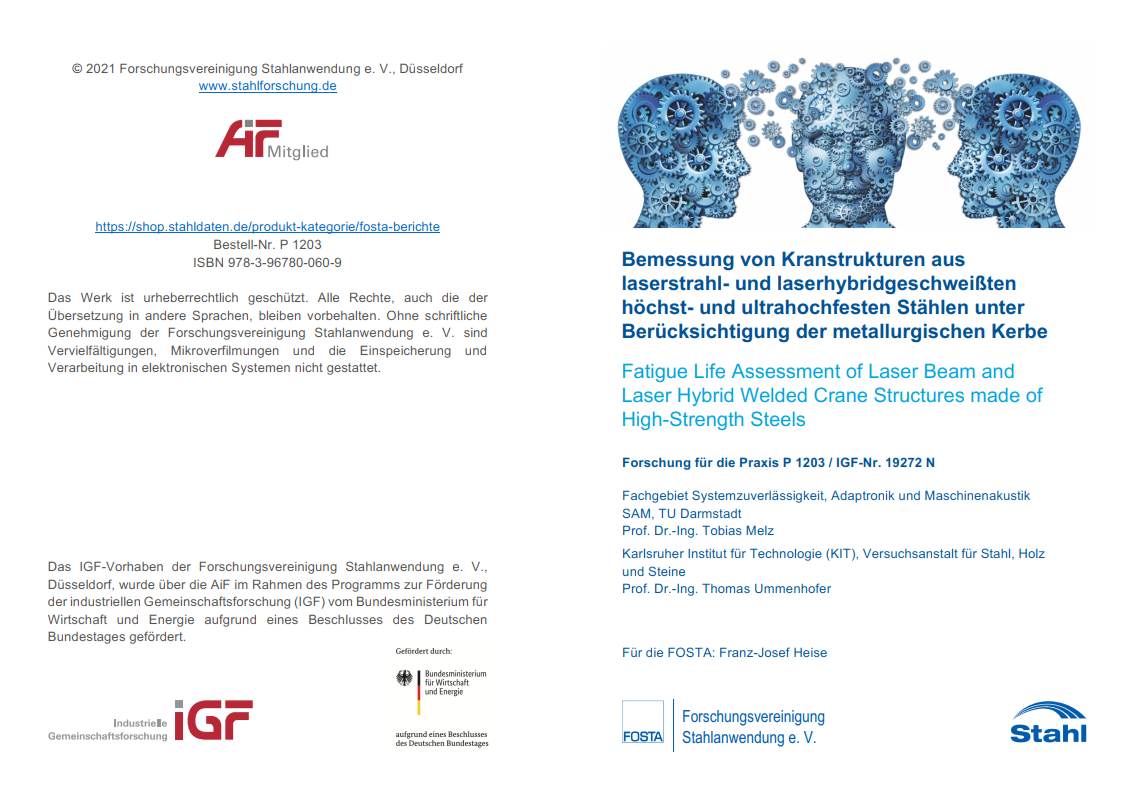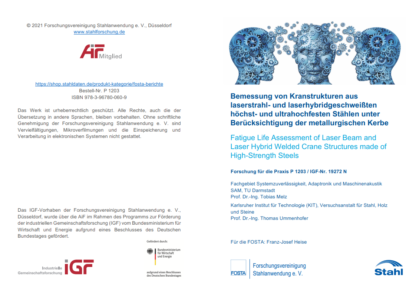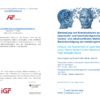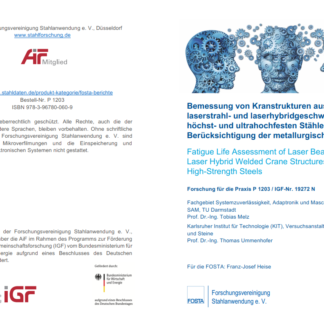Description
P 1203 – Fatigue Life Assessment of Laser Beam and Laser Hybrid Welded Crane Structures made of High-Strength Steels
Motivated by the utilisation of the highest steel grades currently available on the market, also in joints, the research project aims at the reliable and fatigue-related use of laser beam and laser hybrid welded joints made of high-strength and ultra-high-strength finegrain structural steels. Specifically, this applies against the background of the application in highly stressed areas of load-bearing structures, such as they occur in tensile areas of the telescopic boom of mobile cranes. Four fine-grained structural steels of different strength classes, one (very) high-strength (S960) and three ultra high-strength
(S1100 and S1300), produced in different manufacturing processes (quenched-tempered and thermomechanically rolled), constitute the basis for this investigation.
The laser beam welding process variants, laser beam without filler metal and laserGMAW-hybrid, are used to manufacture three welded construction details, butt joints without and with variation in sheet thickness and longitudinal stiffeners. As a result of the specimens’ welding, quality levels B or B90 are achieved, regardless of the base material. Significant weld irregularities are predominantly found in pronounced weld reinforcement (top and bottom) and weld undercuts (especially for laser hybrid welds). Laser measurements of the manufactured specimens show very slight (laser beam) to moderate angular misalignments (laser hybrid). Hardness measurements show high hardness values and gradients from the weld metal to the visible HAZ and, depending on the base material and as a result of the subsequent heat input, low hardness values, i. e. a significant hardness drop, in the tempering zone. The exception here is the S1100M, where hardness values in the tempering zone are at the level of the base material. In Charpy-V impact tests, for the notch position in the weld metal, only low impact energy values are found; for the notch position in the HAZ, the scatter of the determined impact energy values increases, and a crack deviation in other grain structure zones is more often found in the fracture surface analysis.
The fatigue tests show for the laser beam welded butt joints consistently a higher fatigue strength compared to the laser hybrid welds under both constant and variable amplitude loading – clearly for butt joints without variation in sheet thickness, but at least moderately for butt joints with variation in sheet thickness. A very high fatigue strength of the laser-welded butt joint made of S1100QL is striking compared to the other laser-welded series. The fracture surface analysis provides no to few weld imperfections for both the laser beam and laser hybrid welds. The sample components made of S1300QL selected with respect to applications in the telescopic boom of mobile cranes show a high agreement with the corresponding laser beam welded butt joint test series. From the linear damage accumulation, the recommendation of a damage sum of 0.5 is confirmed for maximum values of the load spectrum in the range of the S-N line before the knee point and various modifications, resulting in conservative results in approx. 97 % of the cases. The applicability of the local fatigue strength assessment by the notch stress concept is shown by the example of the S1100QL butt welds by comparing the recommended FAT class FAT 500 (k = 5.0) for the reference radius rref = 0.05 mm. However, compared to the recommended FAT classes, a reliable estimation is not consistently possible. The overall applicability therefore needs to be checked for further specific cases.
In addition, the application of the notch strain concept with the reference radii rref = 1.00 mm and rref = 0.05 mm and the cyclic material behaviour of the S1100QL is discussed on basis of the scatter of results. For the combination of rref = 0.05 mm and the damage parameter PSWT, the overall lowest scatter results in the range of 1.32 ≤ 1 : TP ≤ 1.36. However, it is shown that the consideration of the scatter as the sole criterion of the estimation quality is not sufficient.
For the classification of the fatigue strength results according to the nominal stress concept in the relevant design rules, a consideration of the various welded details, independent of the base material and differentiated according to the welding process variant (laser beam without filler metal or laser hybrid), justified by the different weld geometry etc., proves to be expedient. Instead limiting the design S-N curve to N 10,000 as it is the case in the relevant recommendations, the definition of the upper starting point is based on a maximum cyclic stress, which is depending on the base material strength and the level of the highest experimentally determined maximum stress below the corresponding deformation limit. In this way, a linear extension of the Wöhler line up to this stress range or a fatigue life of significantly less than 10,000 cycles is possible and experimentally verified, whereby the application of the nominal stress concept is extended to a practically relevant service life range.
The presented economic study compares the examined laser beam welding variants with the conventional MSG manufacturing variants from an economical point of view. It is shown that the more detailed the analysis is to be carried out, the more specifically the selected boundary conditions must be defined, which is why two different levels of detail for the studies are chosen. Basically, a reduction in labour costs and processing times can be determined for the laser welding processes and for two different reference examples. In the case of large component production, which is characterised by high times of availability, the acquisition costs decisively determine the equipment cost rates. The laser hybrid variant proves to be particularly cost-efficient due to the lowcost weld preparation, the high welding speed and the single-pass welding. The methodical approach of setting a technical target value (e. g. fatigue strength) in direct correlation to the costs shows that for example a high fatigue strength at N = 2·106 in the “as welded” condition cannot be achieved with all process variants. In general it can be stated that the specific application not only plays a decisive role in cost estimation, but also provides the framework conditions for the manufacture and use of ultra-highstrength and ultra-high-strength fine-grained structural steels and their welded joints.
Published in:
2021
Authors:
Prof. Dr.-Ing. T. Melz, Prof. Dr.-Ing. T. Ummenhofer




